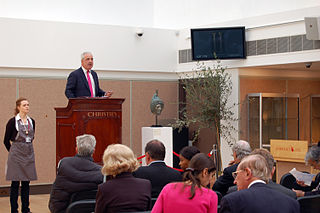
An auction is usually a process of buying and selling goods or services by offering them up for bids, taking bids, and then selling the item to the highest bidder or buying the item from the lowest bidder. Some exceptions to this definition exist and are described in the section about different types. The branch of economic theory dealing with auction types and participants' behavior in auctions is called auction theory.
A royalty payment is a payment made by one party to another that owns a particular asset, for the right to ongoing use of that asset. Royalties are typically agreed upon as a percentage of gross or net revenues derived from the use of an asset or a fixed price per unit sold of an item of such, but there are also other modes and metrics of compensation. A royalty interest is the right to collect a stream of future royalty payments.
In finance, valuation is the process of determining the value of a (potential) investment, asset, or security. Generally, there are three approaches taken, namely discounted cashflow valuation, relative valuation, and contingent claim valuation.

Sotheby's is a British-founded multinational corporation with headquarters in New York City. It is one of the world's largest brokers of fine and decorative art, jewellery, and collectibles. It has 80 locations in 40 countries, and maintains a significant presence in the UK.
Market value or OMV is the price at which an asset would trade in a competitive auction setting. Market value is often used interchangeably with open market value, fair value or fair market value, although these terms have distinct definitions in different standards, and differ in some circumstances.
Real estate appraisal, property valuation or land valuation is the process of assessing the value of real property. Real estate transactions often require appraisals because every property has unique characteristics. The location also plays a key role in valuation. Appraisal reports form the basis for mortgage loans, settling estates and divorces, taxation, and so on. Sometimes an appraisal report is used to establish a sale price for a property.
The Rothko case was the protracted legal dispute between Kate Rothko, the daughter of the painter Mark Rothko; the painter's estate executors; and the directors of his gallery, Marlborough Fine Art. The revelations in the case of greed, abuses of power and conspiracy by financial interests in the art world were described by the New York Court of Appeals, the highest court of New York state, as "manifestly wrongful and indeed shocking", serving as a cautionary tale for both artists and their gallerists.
Business valuation is a process and a set of procedures used to estimate the economic value of an owner's interest in a business. Here various valuation techniques are used by financial market participants to determine the price they are willing to pay or receive to effect a sale of the business. In addition to estimating the selling price of a business, the same valuation tools are often used by business appraisers to resolve disputes related to estate and gift taxation, divorce litigation, allocate business purchase price among business assets, establish a formula for estimating the value of partners' ownership interest for buy-sell agreements, and many other business and legal purposes such as in shareholders deadlock, divorce litigation and estate contest.

An art auction or fine art auction is the sale of art works, in most cases in an auction house.

Auction theory is a branch of applied economics that deals with how bidders act in auctions and researches how the features of auctions incentivise predictable outcomes. Auction theory is a tool used to inform the design of real-world auctions. Sellers use auction theory to raise higher revenues while allowing buyers to procure at a lower cost. The confluence of the price between the buyer and seller is an economic equilibrium. Auction theorists design rules for auctions to address issues that can lead to market failure. The design of these rulesets encourages optimal bidding strategies in a variety of informational settings. The 2020 Nobel Prize for Economics was awarded to Paul R. Milgrom and Robert B. Wilson "for improvements to auction theory and inventions of new auction formats."

An art dealer is a person or company that buys and sells works of art, or acts as the intermediary between the buyers and sellers of art.

Economics of the arts and literature or cultural economics is a branch of economics that studies the economics of creation, distribution, and the consumption of works of art, literature and similar creative and/or cultural products. For a long time, the concept of the "arts" were confined to visual arts and performing arts in the Anglo-Saxon tradition. Usage has widened since the beginning of the 1980s with the study of cultural industry and the economy of cultural institutions. The field is coded as JEL: Z11 in the Journal of Economic Literature classification system used for article searches.
Artnet.com is an art market website. It is operated by Artnet Worldwide Corporation, which has headquarters in New York City. It is owned by Artnet AG, a German publicly-traded company based in Berlin that is listed on the Frankfurt Stock Exchange. The company increased revenues by 25.3% to €17.3 million in 2015 compared with a year before.
Park West Gallery is a commercial art gallery based in Southfield, Michigan, United States. Park West Gallery claims to be the largest private art gallery in the world, but that is largely disputed, and that it has sold hundreds of works of art for thousands of dollars. It exhibits work from historic artists such as Renoir, Picasso, Rembrandt, and Durer as well as contemporary artists such as Peter Max, Michael Godard and Mark Kostabi. The gallery derives the majority of its revenue from auctions that take place aboard cruise ships.
Blockage discount is an art-business-related and legal term of art for referring to the money discount assigned to a group of artworks by a single artist when that group of works is to be released to market as a group rather than individually. A blockage discount adjusts the fair market value of the works downward because of the risks of depreciation when a large volume of art is released into the market all at once.

Most local governments in the United States impose a property tax, also known as a millage rate, as a principal source of revenue. This tax may be imposed on real estate or personal property. The tax is nearly always computed as the fair market value of the property, multiplied by an assessment ratio, multiplied by a tax rate, and is generally an obligation of the owner of the property. Values are determined by local officials, and may be disputed by property owners. For the taxing authority, one advantage of the property tax over the sales tax or income tax is that the revenue always equals the tax levy, unlike the other types of taxes. The property tax typically produces the required revenue for municipalities' tax levies. One disadvantage to the taxpayer is that the tax liability is fixed, while the taxpayer's income is not.

The art market is the marketplace of buyers and sellers trading in commodities, services, and works of art.

An art gallery is a room or a building in which visual art is displayed. In Western cultures from the mid-15th century, a gallery was any long, narrow covered passage along a wall, first used in the sense of a place for art in the 1590s. The long gallery in Elizabethan and Jacobean houses served many purposes including the display of art. Historically, art is displayed as evidence of status and wealth, and for religious art as objects of ritual or the depiction of narratives. The first galleries were in the palaces of the aristocracy, or in churches. As art collections grew, buildings became dedicated to art, becoming the first art museums.















